
Burnet Rhett Maybank was a three-term US senator, the 99th governor of South Carolina, and mayor of Charleston, South Carolina. He was the first governor from Charleston since the American Civil War (1861-1865) and one of twenty people in United States history to have been elected mayor, governor, and United States senator. During his tenure in the Senate, Maybank was a powerful ally of President Franklin D. Roosevelt. His unexpected death on September 1, 1954, from a heart attack, led to Strom Thurmond being elected senator.
Rainbow Row is the name for a series of thirteen colorful historic houses in Charleston, South Carolina. The houses are located north of Tradd St. and south of Elliott St. on East Bay Street, that is, 79 to 107 East Bay Street. The name Rainbow Row was coined after the pastel colors they were painted as they were restored in the 1930s and 1940s. It is a popular tourist attraction and is one of the most photographed parts of Charleston.
Riverland Terrace is a historic neighborhood in Charleston, South Carolina. It was first developed starting in 1925. It is one of James Island, South Carolina's oldest neighborhoods. The Terrace is located 10 minutes west of downtown Charleston along Wappoo Creek and the inland waterway. The neighborhood boasts a public boat landing, Charleston Municipal Golf Course, a playground, five restaurants and numerous antique shops.
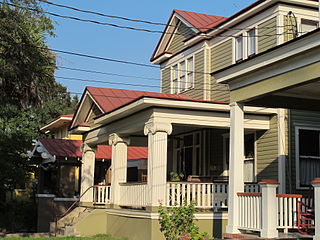
Hampton Park Terrace is the name both of a neighborhood and a National Register district located in peninsular Charleston, South Carolina. The neighborhood is bounded on the west by The Citadel, on the north by Hampton Park, on the east by Rutledge Ave., and on the south by Congress St. In addition, the one block of Parkwood Ave. south of Congress St. is considered, by some, to be included. The National Register district, on the other hand, is composed of the same area with two exceptions: (1) the northeasternmost block is excluded and (2) an extra block of President St. is included.
David Burns Hyer was an American architect who practiced in Charleston, South Carolina and Orlando, Florida during the first half of the twentieth century, designing civic buildings in the Neoclassical Revival and Mediterranean Revival styles.
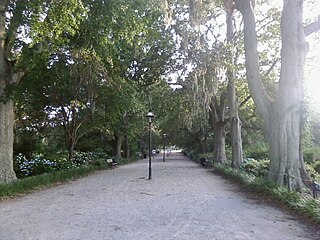
Hampton Park is a public park located in peninsular Charleston, South Carolina, United States. At 60 acres (240,000 m2), it is the largest park on the peninsula. It is bordered by The Citadel to the west, Hampton Park Terrace to the south, North Central to the east, and Wagener Terrace to the north. The park is named in honor of Confederate General Wade Hampton III who, at the time of the Civil War, owned one of the largest collections of slaves in the South. After the Civil War, Hampton became a proponent of the Lost Cause movement, member of the Red Shirts and governor of South Carolina.
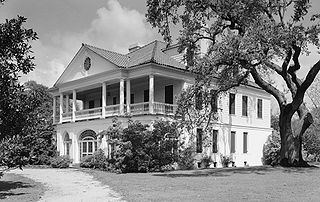
Lowndes Grove, also known as The Grove or Grove Farm, is a waterfront estate built in about 1786 on the Ashley River in Charleston. It is located in the Wagener Terrace neighborhood on a triangular plot of land bordered by St. Margaret Street, 5th Avenue, and 6th Avenue. It was named to the National Register of Historic Places on August 30, 1978.
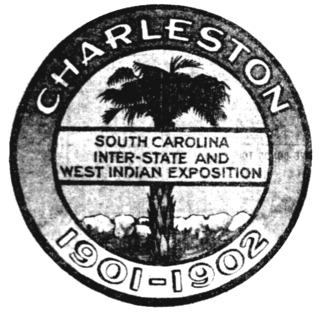
The South Carolina Inter-State and West Indian Exposition, commonly called the Charleston Exposition or the West Indian Exposition, was a multi-county fair and regional trade exposition held in Charleston, South Carolina from December 1, 1901 to June 20, 1902.

Historic Charleston Foundation (HCF) was founded in 1947 to preserve and protect the integrity of the architectural, historical, and cultural heritage of Charleston, South Carolina, United States. The Foundation undertakes advocacy, participation in community planning, educational and volunteer programs, the preservation of historic places, research, and technical and financial assistance programs for the preservation of historic properties. Winslow Hastie has been the President & CEO of Historic Charleston Foundation since 2018.

Albert Wheeler Todd was an architect in Charleston, South Carolina. He is known for his neoclassical architecture, the design on his own home and of a home for Tristram Hyde. Todd was the senior partner at the firm of Todd & Benson which became Todd, Simons & Todd. Joseph F. Leitner worked with him. Todd also served in the legislature from 1910 until 1924 and was a State Senator.
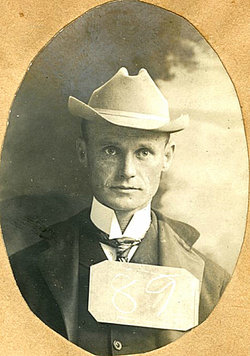
John Darlington Newcomer was an American architect whose practice focused on Charleston, South Carolina in the early 20th century.
Corrine Jones Playground was formerly known as Hester Park because of its location along Hester Street in Charleston, South Carolina. The playground is located on a portion of the larger Buist Tract that had been used during World War II as housing for the influx of wartime workers.

Johann Andreas Wagener (1816-1876) was the forty-third mayor of Charleston, South Carolina, serving one term from 1871 to 1873. He also served as an officer in the Confederate States Army during the American Civil War.

The campus of the Citadel Military College of South Carolina consists of a 300-acre (120 ha) space adjacent to Hampton Park in Charleston, South Carolina. It has been home to the Citadel Military College of South Carolina since 1922 when the school moved from its location on Marion Square, including the Old Citadel. Arranged with the primary buildings surrounding a central 10-acre (4 ha) parade ground, it consists of barracks for the Corps of Cadets, academic buildings, a mess hall, chapel, library, athletic and recreational facilities, support buildings, and housing for faculty and staff.
Stephen Thomas was an architect who practiced mainly in Charleston, South Carolina for about 27 years.
Yeamans Hall Club is a country club built on a 1100-acre tract about 12 miles from Charleston, South Carolina, in the town of Hanahan, South Carolina. It is located along the Cooper River on the site of a 17th-century plantation.
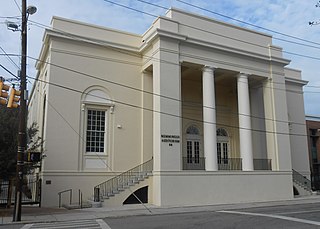
Memminger Auditorium is a live performance and special events venue in Charleston, South Carolina.

Meeting Street Manor is a housing complex located in the upper Eastside in Charleston, South Carolina, and was the city's first housing development. When built in the 1930s, the development was technically two racially segregated halves with separate names. Since desegregation, both components are typically referred to as Meeting Street Manor, originally the name for the Whites-only portion.
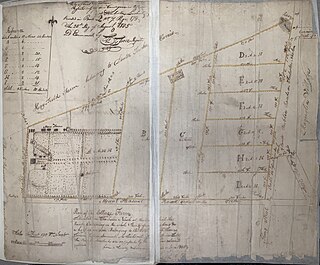
Kiawah Homes is a housing complex located in the Wagener Terrace neighborhood in Charleston, South Carolina. It was built in 1942 as part of a federal housing program for World War II laborers and sold to the Charleston Housing Authority in 1954.














